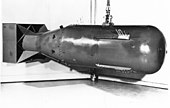| Nuclear weapons |
|---|
 |
| Background |
| Nuclear-armed states |
|
The stability–instability paradox is an international relations theory regarding the effect of nuclear weapons and mutually assured destruction. It states that when two countries each have nuclear weapons, the probability of a direct war between them greatly decreases, but the probability of minor or indirect conflicts between them increases. This occurs because rational actors want to avoid nuclear wars, and thus they neither start major conflicts nor allow minor conflicts to escalate into major conflicts—thus making it safe to engage in minor conflicts. For instance, during the Cold War the United States and the Soviet Union never engaged each other in warfare, but fought proxy wars in Korea, Vietnam, Angola, the Middle East, Nicaragua and Afghanistan and spent substantial amounts of money and manpower on gaining relative influence over the third world.
A study published in the Journal of Conflict Resolution in 2009 quantitatively evaluated the nuclear peace hypothesis, and found support for the existence of the stability–instability paradox. The study determined that while nuclear weapons promote strategic stability, and prevent large scale wars, they simultaneously allow for more lower intensity conflicts. When one state has nuclear weapons, but their opponent does not, there is a greater chance of war. In contrast, when there is mutual nuclear weapon ownership with both states possessing nuclear weapons, the odds of war drop precipitously.
This effect can be seen in the India–Pakistan relationship and to some degree in Russia–NATO relations.
Mechanism
The stability–instability paradox:
"posits that both parties to a conflict will rationally view strategic conflict and the attendant risk of a strategic nuclear exchange as untenable, and will thus avoid any escalation of sub-strategic conflicts to the strategic level. This effective “cap” on sub-strategic militarized conflict escalation emboldens states to engage in such conflict with the confidence that it would not spiral out of control and threaten their strategic interests. The causal force of this theory of increased sub-strategic conflict is the mutual recognition of the untenability of conflict at the level of strategic interests—a product of MAD . With strategic interests forming the “red line” neither side would dare to cross, both sides are free to pursue sub-strategic political objectives through militarized conflict without the fear that the terms of such conflict will escalate beyond their control and jeopardize their strategic interests. Effectively, with the risk of uncontrolled escalation removed, the net costs to engage in conflict are reduced."
See also
References
- Snyder, Glenn Herald (1965). The Balance of Power and the Balance of Terror.
- Jervis, Robert (1979). "Why Nuclear Superiority Doesn't Matter". Political Science Quarterly. 94 (4): 617–633. doi:10.2307/2149629. ISSN 0032-3195. JSTOR 2149629.
- Jervis, Robert (1989). The Meaning of the Nuclear Revolution: Statecraft and the Prospect of Armageddon. Cornell University Press. ISBN 978-0-8014-9565-6.
- Krepon, Michael. "The Stability-Instability Paradox, Misperception, and Escalation Control in South Asia" (PDF). The Henry Stimson Center. Archived from the original (PDF) on 12 August 2017. Retrieved 12 August 2017.
- Rauchhaus, Robert (2009). "Evaluating the Nuclear Peace Hypothesis - A Quantitative Approach". Journal of Conflict Resolution. 53 (2): 258–277. doi:10.1177/0022002708330387. S2CID 34287191.
- Christopher J. Watterson 2017, 'Competing interpretations of the stability–instability paradox: the case of the Kargil War', The Nonproliferation Review, 24(1-2), 86, https://doi.org/10.1080/10736700.2017.1366623
This military-related article is a stub. You can help Misplaced Pages by expanding it. |